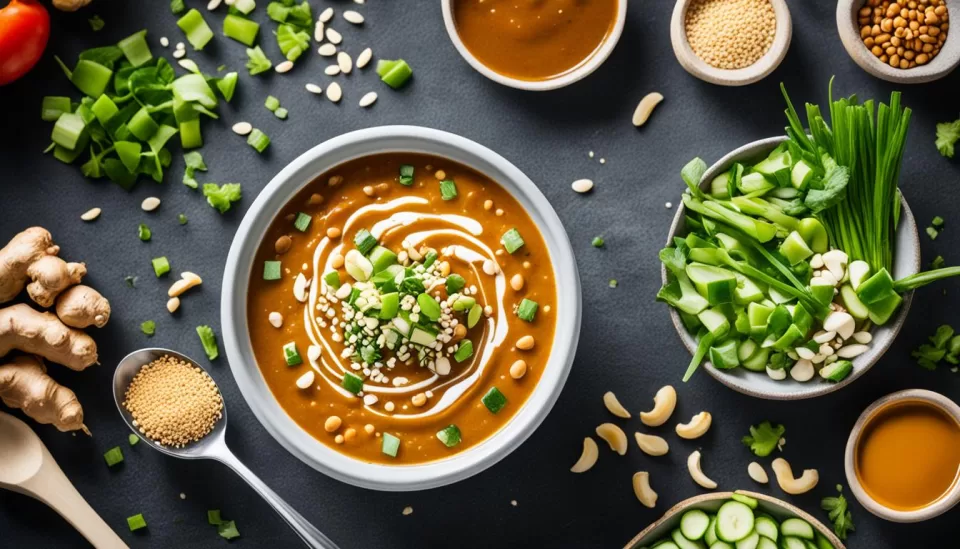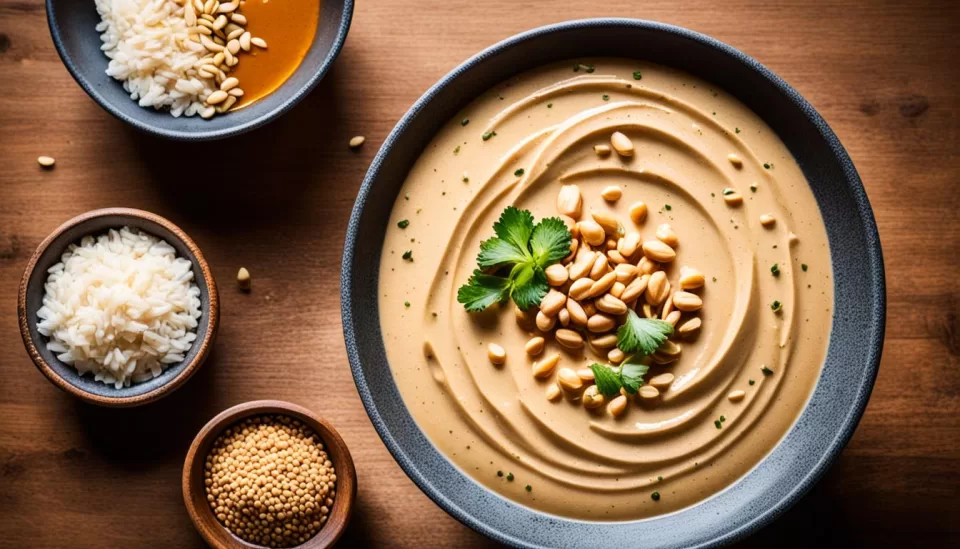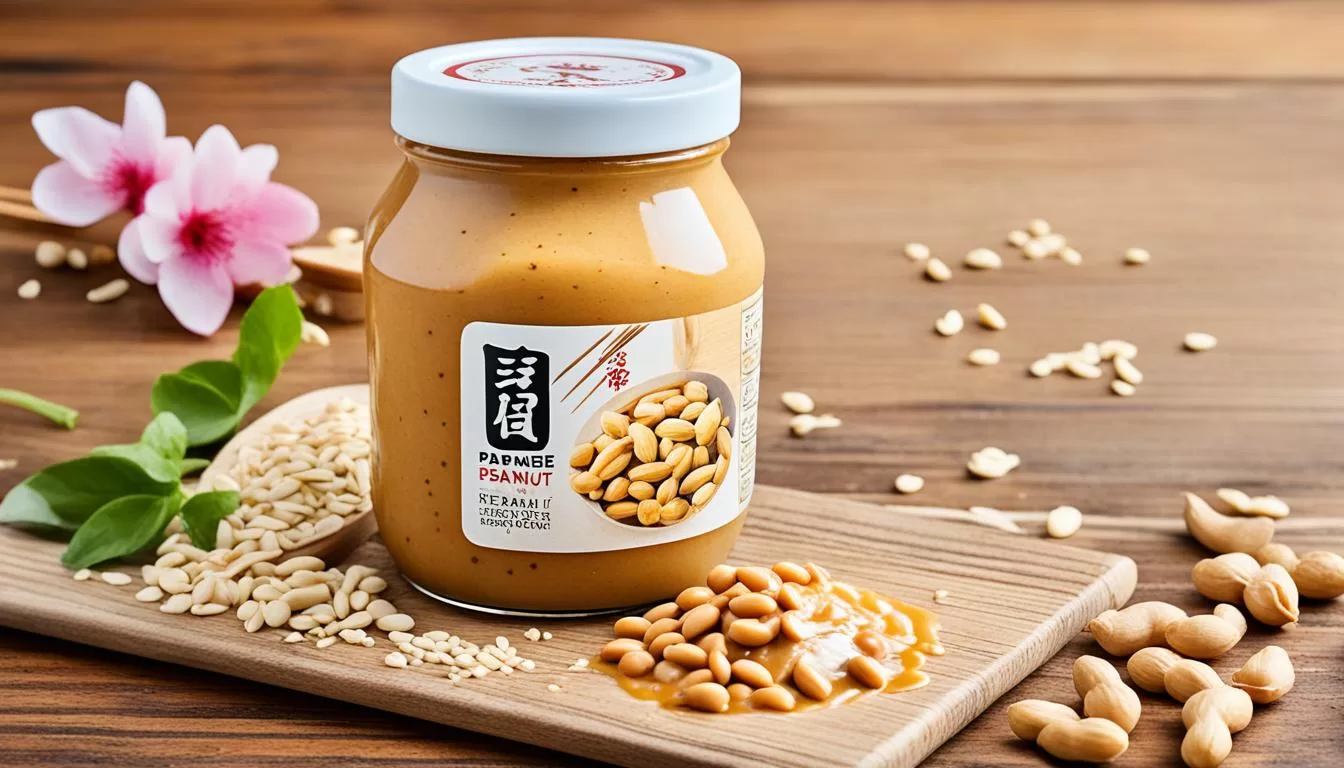Prepare your palate for a culinary journey through the nuanced flavors of Asia with a homemade peanut sauce that stands as a testament to the diverse profiles of Asian cuisine condiments. This gourmet dipping sauce, a creamy blend of aromatic spices and rich textures, originates from the heart of Japanese gastronomy. Envision crafting your very own sesame paste dressing—a delightful combination of traditional taste and innovative flair. As you explore this culinary fusion sauce, you’ll unlock the secret to transforming simple ingredients into an extraordinary ensemble of flavors that elevate your meals from ordinary to exceptional.
Whether you’re a seasoned chef or a home-cooking enthusiast, the steps to achieving the perfect balance between nutty sesame and the subtle tang of rice vinegar await you. Your results? A versatile sauce that not only complements Shabu Shabu but can be the highlight of salads, noodles, and much more. Let’s whisk together tradition and creativity to create a sauce that resonates with every taste bud around your table.
What Makes Japanese Peanut Sesame Sauce a Culinary Delight
Exploring the gastronomic excellence of Japanese Peanut Sesame Sauce reveals why it’s much more than just a nutty sesame spread. The intricate flavors and textures create a savory dipping sauce that elevates simple meals to gourmet experiences. The process of crafting genuine homemade peanut sauce celebrates the art of blending traditional ingredients for a distinctly harmonious taste. This sauce isn’t just a condiment; it embodies the essence of culinary fusion sauce, merging age-old Japanese tradition with the versatility required by modern palates.

The foundational component of this creamy delight is nerigoma, a Japanese sesame paste characterized by its deep richness and robustness. When coupled with the sweet and salty pairing of sugar and soy sauce, plus a base of strong, concentrated dashi, the resulting sauce acquires an unmatched umami profile. These core elements, when combined in the perfect proportions, create a texture so silky and flavors so layered, it pairs seamlessly with a vast array of foods—from crisp vegetables to delicate tofu and hearty noodles.
At home, you can experience this culinary delight by following time-honored techniques, which underscore the importance of exceptional ingredients. Here’s how each component contributes to the iconic sauce:
- Nerigoma: Offers a grounding, nutty base for the sauce’s profile.
- Soy Sauce: Brings a salty, umami kick that heightens intrinsic flavors.
- Sugar: Balances the saltiness with a hint of sweetness.
- Rice Vinegar: Introduces a subtle tang to cut through the richness.
- Dashi: Provides layers of complexity and depth to the sauce.
What elevates this paste to a gourmet staple is its ability to adapt—whether it’s served hot alongside succulent meats or cold as a refreshing vegetable dip, it maintains its integrity. Whether you’re a seasoned chef or an enthusiast of Asian kitchen adventures, integrating the Japanese Peanut Sesame Sauce into your culinary repertoire is a surefire way to impress, delight, and nourish.
Exploring the Origins of Peanut Sesame Sauce in Asian Cuisine
The journey through the rich tapestry of Asian cuisine leads us to one of its most cherished treasures: the peanut sesame sauce. This exquisite condiment, known for its creamy texture and depth of flavor, is not just an Asian cuisine condiment but a cultural touchstone within the culinary heritage of Japan. It’s a symphony in which every drop tells a story of tradition and contemporary innovation.

The Cultural Significance of Goma Dare
When you think of gourmet dipping sauces, think of Goma Dare. Its presence at Japanese dining tables spans centuries, epitomizing the essence of the country’s gastronomic preferences. Elementally linked to the social practice of sharing meals, particularly the harmonious Shabu Shabu, Goma Dare forges connections between food, family, and heritage with every use.
The Versatility of Sesame in Japanese Recipes
From a simple homemade peanut sauce to an intricate sesame paste dressing, sesame seeds and their derivatives have anchored themselves as indispensable contributors to the Japanese flavor palette. Whether it’s invigorating a bowl of noodles or accentuating the natural tastes of sashimi, the adaptability of sesame is unparalleled. Their transformative ability makes them a staple, bridging the gap between generations-old recipes and the dynamic, ever-evolving landscape of modern Japanese cuisine.
- Nutty toppings on rice dishes
- Glazes for savory meat preparations
- Dressings for fresh, crisp salads
- Enriching broths and stews with a deep umami character
Indeed, the storied past and present of these gourmet dipping sauces, highlight how a simple ingredient like sesame can transcend cultural boundaries, finding its way not just into dishes, but into the hearts of food lovers around the world. So, next time you drizzle that homemade peanut sauce over your meal, take a moment to appreciate the historical journey that’s been poured onto your palate.
Essential Ingredients for Crafting Your Homemade Peanut Sauce
Embarking on the journey to create your delectable homemade peanut sauce, the first step is to gather the essential ingredients. The right components will not only ensure authenticity but will also bring out that desirable nutty sesame spread character, making it an indispensable Asian cuisine condiment. Here’s what you’ll need to assemble:
| Ingredient | Role in Sauce | Taste Contribution | Notes |
|---|---|---|---|
| Japanese sesame paste (Nerigoma) | Base substance | Rich nuttiness | Ensure it’s well-stirred for ideal consistency. |
| Soy sauce | Savory liquid component | Umami and saltiness | Choose a traditionally brewed variety for best flavor. |
| Sugar | Sweetness | Subtle sweetness | Adjust depending on your preference for sweetness. |
| Rice vinegar | Acidic balance | Mild tang | Can be replaced with other mild vinegars if necessary. |
| Dashi | Complex flavor base | Depth and complexity | Instant dashi powder offers convenience. |
| Salt | Flavor enhancer | Saltiness | Use sparingly; soy sauce also adds saltiness. |
After preparing these ingredients, it’s crucial to harmonize them into a smooth and luscious sauce. Japanese sesame paste, the heart of your sauce, will provide that distinct texture and taste. The soy sauce and dashi add savory dimensions, while rice vinegar introduces a needed acidity to slice through the richness of the sesame. Sugar and salt are your taste regulators – use them to calibrate the sweet and salty notes to your liking.
Each ingredient should be embraced for its unique qualities and combined with precision to create a sauce that not only honors its traditional roots but also stands as a versatile complement to a myriad of dishes within Asian cuisine. Your culinary adventure begins with these key elements, and from there, the possibilities for gastronomic creativity are endless.
Bringing the Flavors Together: Step-by-Step Guide to the Perfect Sauce
Embarking on the journey to craft your own savory dipping sauce, particularly a homemade peanut sauce enriched with sesame paste dressing, begins with mastering the art of blending the ingredients to create a symphony of flavors. The key is in the details, from the sequence of mixing to the gradual balance of seasoning that makes your sauce stand out. Here’s a concise guide to ensuring your sauce is nothing short of perfection.
Tips for Mixing Your Ingredients
To set the foundation for your sauce, commence with **combining your dry and wet ingredients separately**. Start by thoroughly blending the sugar into your homemade sesame paste. This step is crucial; a hint of graininess can distract from the overall experience of your sauce. Once a harmonious paste is formed, meticulously introduce your soy sauce and rice vinegar. Remember, **patience is your ally** here – add liquids slowly, stirring consistently to maintain a velvety smooth consistency.
Adjusting Texture and Taste to Perfection
The texture of your peanut sesame sauce is a personal endeavor. Some may prefer it thick and rich, while others may like it slightly runnier, ideal for drizzling. Here, your homemade dashi plays a pivoting role; add it bit by bit, checking the consistency after each addition. As taste buds are subjective, don’t hesitate to **tweak the ratios** of your sesame paste or seasoning. If you notice the intensity of your homemade paste is more profound, simply adjust the quantities to suit your preference, ensuring the ultimate savory dipping sauce experience.
With these steps, not only do you honor the traditional way of making this iconic sauce, but you also bring a piece of that culinary authenticity straight into your kitchen.
The Key Difference: Adding a Burst of Flavor to Traditional Peanut Sesame Sauce
When you elevate the traditional peanut sesame sauce to a culinary fusion sauce, each ingredient plays a pivotal role in creating an explosion of taste that stands out in any gourmet spread. By infusing your sauce with toasted sesame seeds and a drizzle of sesame oil, you enrich the already nutty sesame spread with an intense depth of flavor. The dynamic trio of Japanese sesame paste, these freshly toasted seeds, and the warm, enveloping scent of roasted sesame oil coalesce to bring a decadent and aromatic twist to your homemade peanut sauce.
The simple act of grinding katsuobushi into a fine powder, as a substitute for conventional dashi stock, offers an accessibility in preparation without sacrificing the umami-packed essence that is beloved in Asian cooking. With this ingenuity, you achieve a peerless gourmet dipping sauce that captures the essence of traditional flavors while introducing a contemporary zest. Whether it subtly complements fresh vegetables or becomes the heart of a noodle dish, the added sesame elements surely elevate this sauce from a simple condiment to a memorable gastronomic delight.
As you explore the myriad ways to incorporate this elevated nutty sesame spread into your cooking repertoire, remember that the potency of flavors in a well-crafted peanut sesame sauce can transform a simple meal into an extraordinary dining experience. Your adeptness at selecting and combining these enhanced components guarantees a sauce that is not only rooted in the richness of Japanese tradition but also illustrated with your own creative culinary flourishes.

